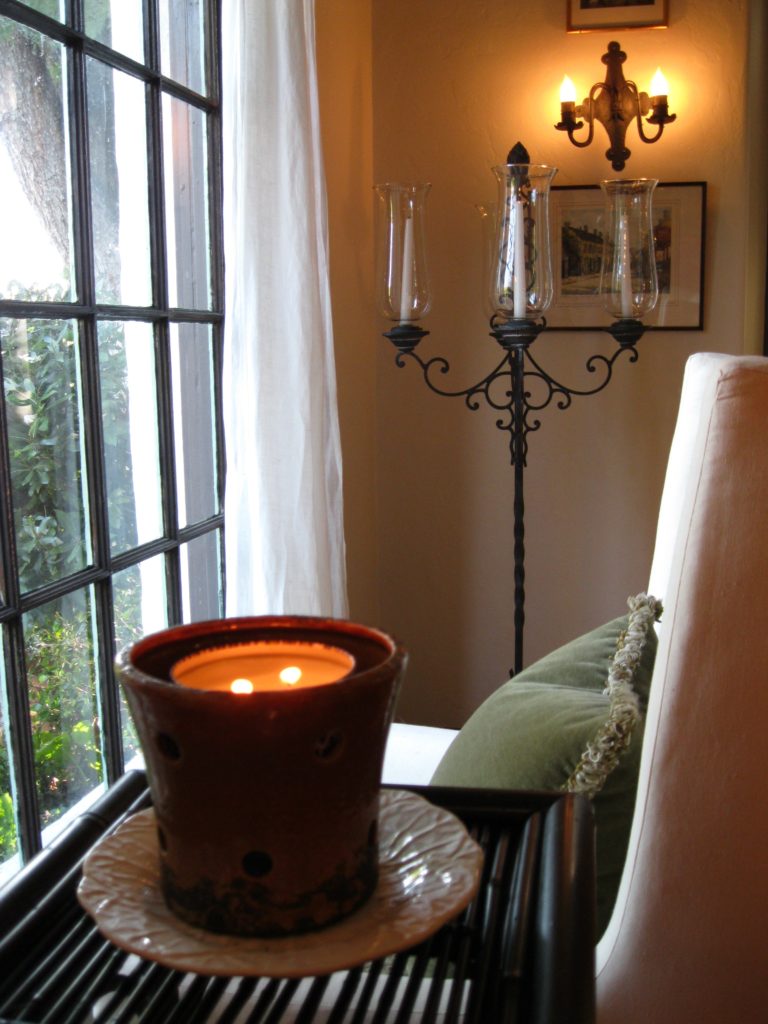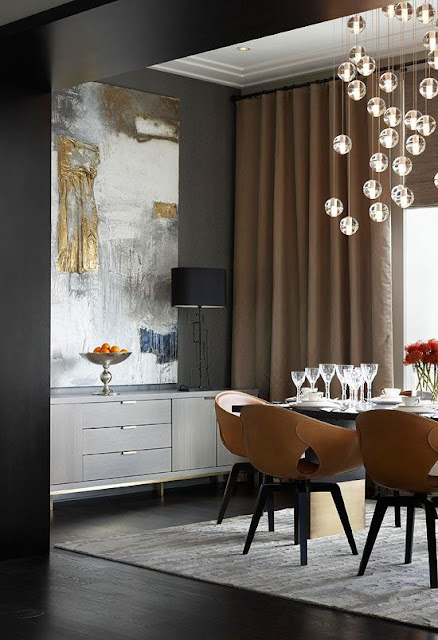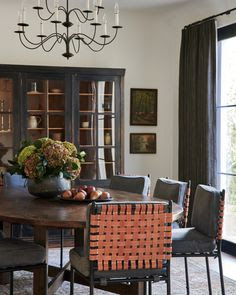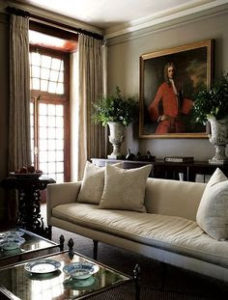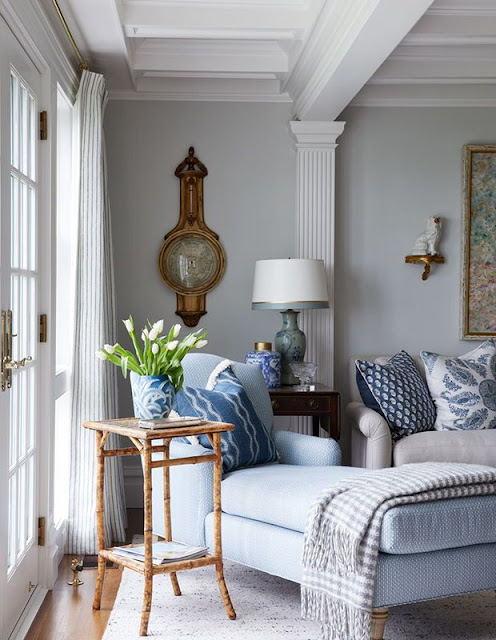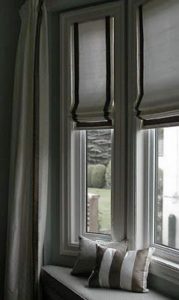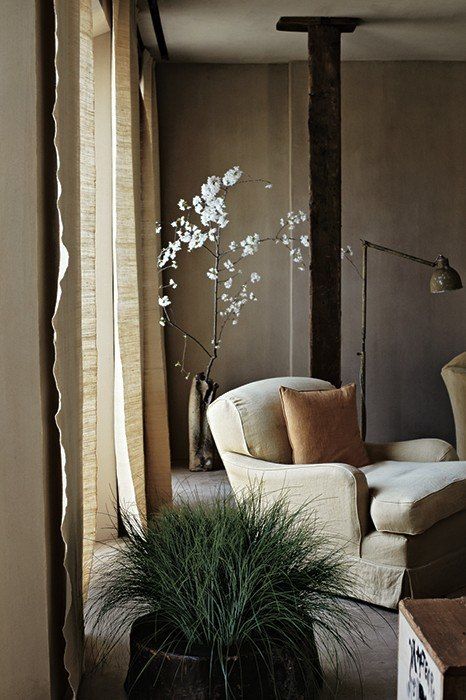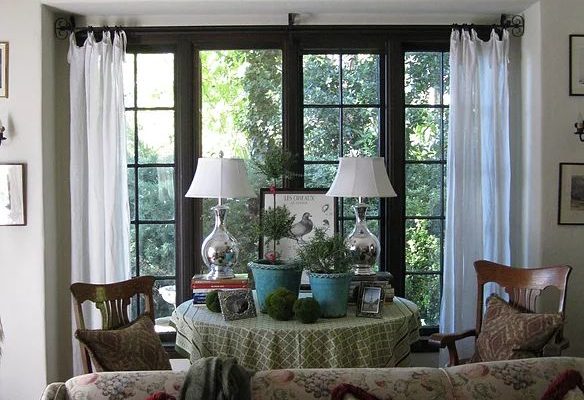If window treatments are something you’re contemplating in the near future, here’s a primer to help get you started with the basics. window treatment decisions made easy on this issue of Joy of Nesting.
Shiree Segerstrom Design
Things to Consider When Deciding on Window Treatments
Among the many considerations in planning new window treatments are exposure to sunlight and cold, outdoor views, the home’s style, window size and style, cost, upkeep, and nearby obstacles.
My Favorite Types of Window Treatments
I’ve done a fair share of custom designed window treatments over the years, and I’ve seen many styles and types come and go. My own preferences lean toward custom draperies on high quality rods with rings and finials; simple, unlined sheers; box pleated board mounted valances; roman shades; traditional wood shutters with small slats; and high-quality woven shades.
Before making any decisions, there are a few questions you will need to ask yourself. I’ll offer tips to prioritizing the budget and planning the styles in a minute.
Shiree Segerstrom Interior Design
Questions to Ask Yourself Before Deciding on Window Treatments
Do you want to plan in stages? If so, I recommend doing the formal living room, dining room, entry, and master bedroom first, and family room, kitchen, guest rooms and baths last. Are your windows attractive and are the views pleasing? If yes, you probably are not going to want them covered up with wooden blinds or shutters. Are the clearances tight? In other words, is there minimal room for treatments and hardware on the outside of the window frame? If yes, an interior mounted treatment might be in order. Are there French doors or glass sliding doors? If yes, the best treatments for those two situations are draperies that coordinate with the other window treatments situated in close proximity.
Doug Atherly
Window Treatment Variables
There are many variables with window treatments. Often times there are more than one style of window in a room requiring visual continuity but with different functions. I often suggest box pleated valances or drapery panels for such contingencies because they allow for varying heights of windows. Layering treatments isn’t always the most cost-efficient choice but for small windows like those found in most bedrooms a valance over drapery panels visually increases the window size, softens noise, and creates a restful and attractive appearance.
Amber Interiors
In mountain homes the views attract many home buyers. In these cases, a “less is more” approach is used, mounting the treatments as far off the glass as possible.
This approach can be tricky because the farther you move the drapery panel off the glass, the bigger the panel’s “stack” becomes. So, while you expose as much glass
as possible, you still end up with a larger “stack”.
Laurel Bern
For homes with unattractive windows and views, wooden blinds or shutters are a lovely solution. Shutters and blinds are always a good investment for resale. Vinyl shutters are an
option that many people overlook. They are very nice looking, very clean, and easy to maintain.
For rooms that are naturally dark I have found unlined sheers on custom iron rods and rings to be beautiful and functional. Iron rods are a lifetime investment and should reflect the architectural style of the home.
To give you an idea of levels of cost, the least expensive custom window treatments would be draperies on a decorative traverse rod; board mounted valances over wooden blinds or sunscreens; some brands of woven shades. In the moderately priced category draperies on rods and rings over sheers and valances over drapery panels; roman shades. In the highest price category are triple layered treatments such as valances over draperies over sheers, and plantation shutters.
Tips for Lowering Costs
To help lower window treatment prices on shutters and blinds wait for annual sales or choose reputable workrooms to do your own fabrication and design. Doing it yourself will require that you estimate fabric quantities and create a viable work order for the work room to follow. For fabric treatments like draperies, shades, and valances aim for fabrics in the $60 per yard range. Trims such as welts, ties, banding, and fringe add to the overall cost.
Some Caveats When Working with a Designer on Window Treatments
Most designers won’t work with fabric you have purchased at discount stores preferring instead to provide you with the fabric themselves. There is a lot of extra foot work using
the client’s own fabric such as driving or taking the time to ship it to the seamstress: when we order fabrics from our own sources, they automatically ship it directly to our workrooms; frequently the fabric has flaws; and often times there isn’t enough fabric to complete the job.
Window treatments are time consuming and technically challenging. For that reason, the mark-up we receive from purchasing fabric at wholesale and selling at retail is important to cover our time. However, there are fabric store chains in most major cities that will sell you the fabric and fabricate the product saving you considerable money. The draw backs are that workmanship isn’t always great and the styles tend to date quickly. If you know what you want and wish to be the designer yourself, hiring an experienced seamstress is a great option. They are usually willing to work with your own material too. Choose seamstresses that have at least 15 years of experience otherwise you won’t be happy with the end result.
Sheila Bouttier
Colors for Window Treatment Fabrics and Materials
When choosing shutters, blinds, or shades pay attention to the colors. In large amounts whites can be so white they make everything else in the room dingy. With fabric treatments if
you are going to play it safe, go all the way by choosing a nice neutral colored fabric like warm white or light taupe. Otherwise, be brave and choose a subtle print that will coordinate well with existing furnishings. Avoid the in-betweens.
Download Your Free Gift
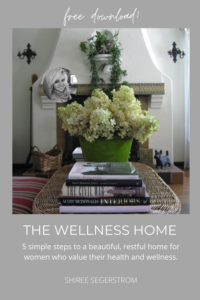
To get started on a home where you feel healthy, happy and connected grab my complimentary design and wellness download, The Wellness Home.
It’s the prettiest little book. It’s a quick read with super easy design solutions that help you lead a beautiful, healthier lifestyle at home, plus my 3-to-5 Things Framework that gives you step by step actions to get started and stay on track.
That’s it for today. Thank you for stopping by!
Shiree’
What is Wellness Design? Learn more about the connection between your wellbeing and your home, featured on Deirdre Fitzpatrick’s Dying to Ask Podcast. And if you’d like to dive deeper into this topic, check out my blog post, “Hiring an Interior Designer”.

